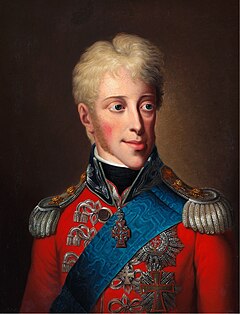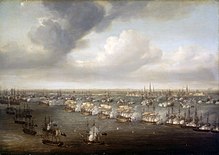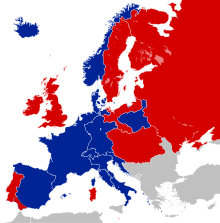
The Napoleonic Wars (1803–1815) were a series of conflicts fought between the First French Empire under Napoleon (1804–1815) and a fluctuating array of European coalitions. The wars originated in political forces arising from the French Revolution (1789–1799) and from the French Revolutionary Wars (1792–1802), and produced a period of French domination over Continental Europe. The wars are categorised as seven conflicts, five named after the coalitions that fought Napoleon, plus two named for their respective theatres; the War of the Third Coalition, War of the Fourth Coalition, War of the Fifth Coalition, War of the Sixth Coalition, War of the Seventh Coalition, the Peninsular War, and the French invasion of Russia.
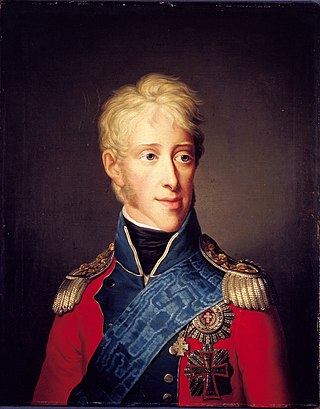
Frederick VI was King of Denmark from 13 March 1808 until his death in 1839 and King of Norway from 13 March 1808 to 7 February 1814. He was the last king of Denmark–Norway. From 1784 until his accession, he served as regent during his father's mental illness and was referred to as the "Crown Prince Regent". For his motto he chose God and the just cause and since the time of his reign, succeeding Danish monarchs have also chosen mottos in the Danish language rather than the formerly customary Latin.

Sweden and Norway or Sweden–Norway, officially the United Kingdoms of Sweden and Norway, and known as the United Kingdoms, was a personal union of the separate kingdoms of Sweden and Norway under a common monarch and common foreign policy that lasted from 1814 until its peaceful dissolution in 1905.
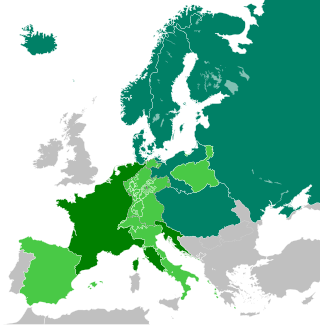
The Continental Blockade, or Continental System, was a large-scale embargo by Napoleon Bonaparte against the British Empire from 21 November 1806 until 11 April 1814, during the Napoleonic Wars. Napoleon issued the Berlin Decree on 21 November 1806 in response to the naval blockade of the French coasts enacted by the British government on 16 May 1806. The embargo was applied intermittently, ending on 11 April 1814 after Napoleon's first abdication.

The krone is the official currency of Denmark, Greenland, and the Faroe Islands, introduced on 1 January 1875. Both the ISO code "DKK" and currency sign "kr." are in common use; the former precedes the value, the latter in some contexts follows it. The currency is sometimes referred to as the Danish crown in English, since krone literally means crown. Historically, krone coins have been minted in Denmark since the 17th century.

The Napoleonic era is a period in the history of France and Europe. It is generally classified as including the fourth and final stage of the French Revolution, the first being the National Assembly, the second being the Legislative Assembly, and the third being the Directory. The Napoleonic era begins roughly with Napoleon Bonaparte's coup d'état, overthrowing the Directory, establishing the French Consulate, and ends during the Hundred Days and his defeat at the Battle of Waterloo. The Congress of Vienna soon set out to restore Europe to pre-French Revolution days. Napoleon brought political stability to a land torn by revolution and war. He made peace with the Roman Catholic Church and reversed the most radical religious policies of the Convention. In 1804 Napoleon promulgated the Civil Code, a revised body of civil law, which also helped stabilize French society. The Civil Code affirmed the political and legal equality of all adult men and established a merit-based society in which individuals advanced in education and employment because of talent rather than birth or social standing. The Civil Code confirmed many of the moderate revolutionary policies of the National Assembly but retracted measures passed by the more radical Convention. The code restored patriarchal authority in the family, for example, by making women and children subservient to male heads of households.

The Scandinavian Monetary Union was a monetary union formed by Denmark and Sweden on 5 May 1873, with Norway joining in 1875. It established a common currency unit, the krone/krona, based on the gold standard. It was one of the few tangible results of the Scandinavian political movement of the 19th century. The union ended during World War I.
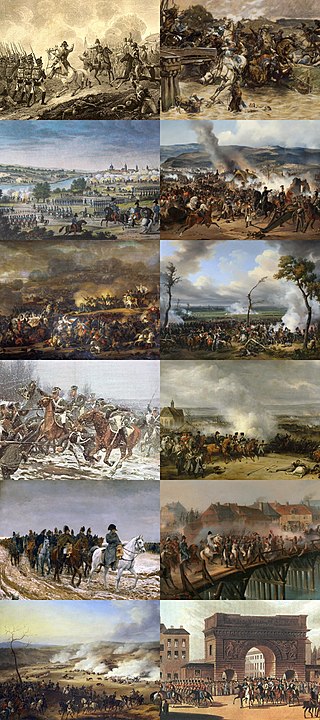
In the War of the Sixth Coalition, sometimes known in Germany as the Wars of Liberation, a coalition of Austria, Prussia, Russia, Spain, Great Britain, Portugal, Sweden, Sardinia, and a number of German States defeated France and drove Napoleon into exile on Elba. After the disastrous French invasion of Russia of 1812 in which they had been forced to support France, Prussia and Austria joined Russia, the United Kingdom, Sweden, and Portugal, and the rebels in Spain who were already at war with France.

The Treaty of Kiel or Peace of Kiel was concluded between the United Kingdom of Great Britain and Ireland and the Kingdom of Sweden on one side and the Kingdoms of Denmark and Norway on the other side on 14 January 1814 in Kiel. It ended the hostilities between the parties in the ongoing Napoleonic Wars, where the United Kingdom and Sweden were part of the anti-French camp while Denmark–Norway was allied to France.

The Battle of Sehested was fought between Danish and Russian-Prussian-British troops at Sehested on 10 December 1813 during the War of the Sixth Coalition. The Danish Auxiliary Corps, which fought on the side of the French defeated the coalition forces commanded by Major General Ludwig von Wallmoden-Gimborn.
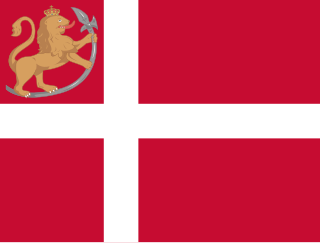
In 1814, the Kingdom of Norway made a brief and ultimately unsuccessful attempt to regain its independence. While Norway had always legally been a separate kingdom, since the 16th century it had shared a monarch with Denmark; Norway was a subordinate partner in the combined state, whose government was based in Copenhagen. Due to its alliance with France during the Napoleonic Wars, Denmark was forced to sign the Treaty of Kiel in January 1814 ceding Norway to Sweden.
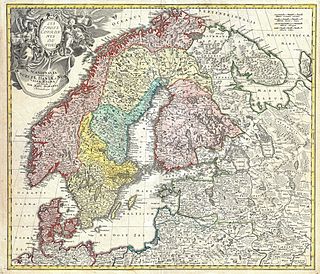
The history of Scandinavia is the history of the geographical region of Scandinavia and its peoples. The region is located in Northern Europe, and consists of Denmark, Norway and Sweden. Finland and Iceland are at times, especially in English-speaking contexts, considered part of Scandinavia.
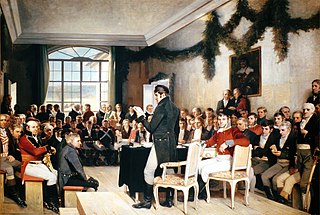
The Swedish–Norwegian War, also known as the Campaign against Norway, War with Sweden 1814, or the Norwegian War of Independence, was a war fought between Sweden and Norway in the summer of 1814. According to the Treaty of Kiel, Norway would enter a union with Sweden under Charles XIII of Sweden. The war resulted in Norway being forced into the United Kingdoms of Sweden and Norway, but with its own constitution and parliament. The war marked the last time Sweden participated in an armed conflict with another nation, and its conclusion signalled the beginning of the country's long period of military neutrality.

The rigsdaler was the name of several currencies used in Denmark until 1875. The similarly named Reichsthaler, riksdaler and rijksdaalder were used in Germany and Austria-Hungary, Sweden and the Netherlands, respectively. These currencies were often anglicized as rix-dollar or rixdollar.

Danmarks Nationalbank is the central bank of the Kingdom of Denmark. It is a non-eurozone member of the European System of Central Banks (ESCB). Since its establishment in 1818, the objective of the Nationalbank as an independent and credible institution is to issue the Danish currency, the krone, and ensure its stability. The Board of Governors holds full responsibility for the monetary policy.

British–Danish relations are foreign relations between the United Kingdom and Denmark. The United Kingdom has an embassy in Copenhagen and Denmark has an embassy in London. Both countries are full members of Council of Europe and NATO.

The Battle of Bornhöved or Bornhöft took place on 7 December 1813 between a Swedish cavalry regiment under Bror Cederström and Prince Frederik of Hesse's Danish troops reinforced by smaller numbers of Polish cavalry and German infantry. The clash occurred at the small village of Bornhöft in what is now Schleswig-Holstein in north Germany. The engagement occurred during the War of the Sixth Coalition, part of the Napoleonic Wars, and was the last time Swedish and Danish forces met on the battlefield.

The English Wars were a series of conflicts pitting the United Kingdom and Sweden against Denmark-Norway as part of the Napoleonic Wars. It is named after England, the common name in Scandinavia for the United Kingdom, which declared war on Denmark-Norway due to disagreements over the neutrality of Danish trade and to prevent the Danish fleet falling into the hands of the First French Empire. It began with the Battle of Copenhagen (1801) and its latter stage from 1807 onwards was followed by the Gunboat War, the Dano-Swedish War of 1808–09 and the Swedish invasion of Holstein in 1814.
